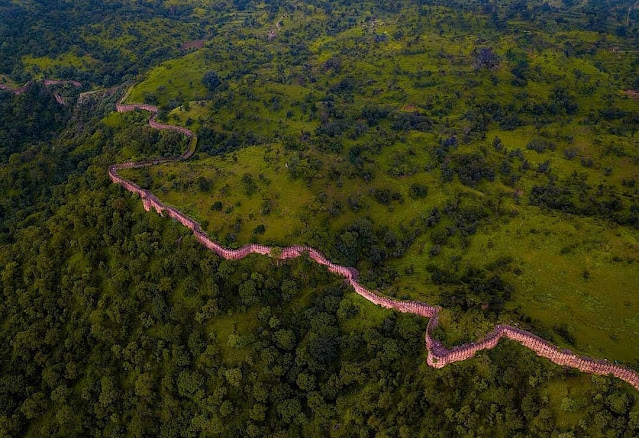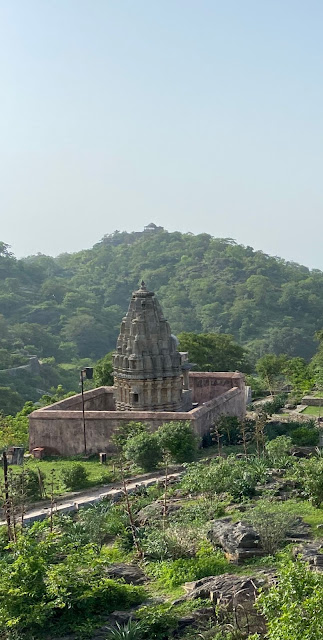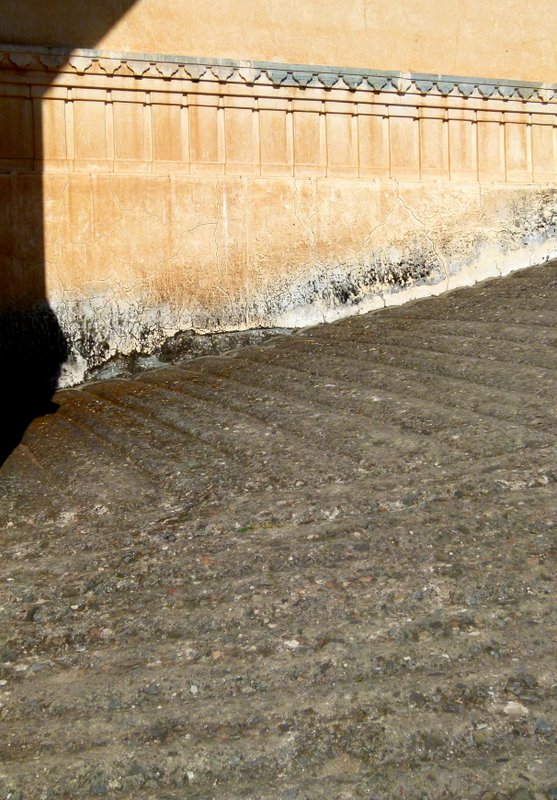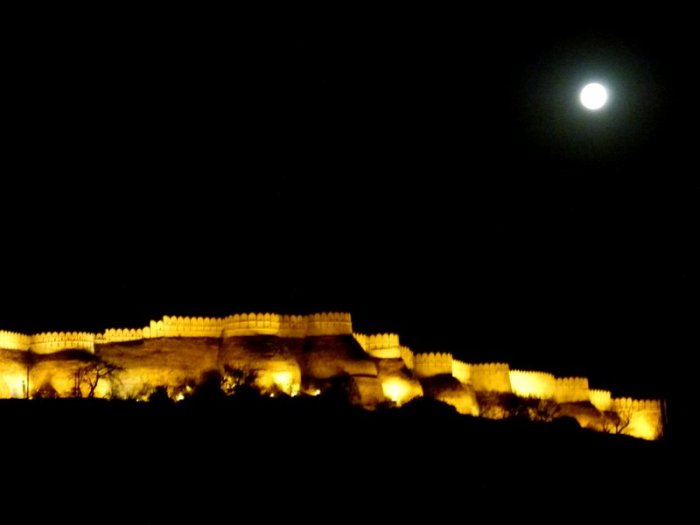India just not have World Second largest Population after China, but also the Second longest Wall in the World. Worth mentioning: But Unlike The Great Wall, human remains DO NOT form the foundation of this wall.
Thoughts of Rajasthan ( Land Of Kings ) bring a kaleidoscope of images to the mind, ranging from colourful turbans, traditional jewellery, tunes of soulful music, whiffs of delectable food and, of course, mighty forts.
The forts of Rajasthan actually have played a significant role in building the unique culture of the state and the many facets of the fascinating land. In every corner of the vast state, you will find forts that still stand tall and mighty, as proof of the land’s royal history and the pomp and regalia of the fabled rajas and maharajas who built them. One stood out among them is the mighty Kumbhalgarh..
Situated 82 km northwest of Udaipur, Kumbhalgarh lies in the Rajsamand district of Rajasthan and was declared a UNESCO World Heritage Site in 2013, together with five other forts.
Made by Dharmik kings for protection of Dharma. The fort, as we see it today, was constructed by MahaRana Kumbha in the 15th century. Of all the forts he built, Kumbhalgarh is the most impressive. The massive fort stands as a testimony to the grandeur of the ruler.
Kumbhalgarh is surrounded by a 36 km long wall, which is assumed to be the second longest wall in the world, after the Great Wall of China. The main citadel is perched high up, and one must make way through the monumental gates and then to the top to witness the fort in its glory.
As the height increases, one can take in the marvelous views of the infinite wall covered in lush wilderness, sheltering various palaces and temples.
According to legend, the chief architect Mandan oversaw the construction of the fort, which took 15 years to be completed. It is also said that Rana Kumbha faced many problems while building the fort, but a human sacrifice solved them all. Monuments were then built in memory of the man who volunteered for the sacrifice.
The fort was built taking advantage of the defensive properties of the terrain. Nestled in the Aravalli valley, the fort was virtually impregnable, and its unique military design helped keep conquerors at bay. Only on one occasion it could not defend itself when under a siege, and that too because of scarcity of drinking water.
With its strong architecture, splendour and regalia, Kumbhalgarh captures the imagination as a lasting image of Rajput grandeur that stands out for its fascinating history.
We all know about the Great Wall of China, the largest wall ever built. It is a wall with a myriad of stories, including various mythological and historical appraisals. Chinese prisoners in the past were sent there to serve their sentence. the chances are that fewer people have heard of the Kumbhalgarh Fort and its surrounding wall, widely agreed to be the second largest wall in the world.
Distant view of the Kumbhalgarh Fort walls.
Kumbhalgarh is a site that sits nestled in-between 13 towering mountain peaks in the western part of India. To be more precise, it can be found in the state of Rajasthan, roughly 50 miles from the city of Udaipur.

The Palace Complex at the top of the Kumbhalgarh Fort
Found among the mountaintops, the Kumbhalgarh Fort is a 15th-century masterpiece built by Rana Kumbha. The site also counts as the birthplace of one of the greatest Mewar rulers and warriors known as Maharana Pratap.
However, this area was considered to be of high strategic importance long before the Kumbha dynasty came to prominence. The very first fort to occupy the spot at Kumbhalgarh was there as early as the 6th century. Back then, it was King Samprati of the Maura Age who constructed it. A majority of historians consider him a peace-loving ruler, and a very courageous king. He had managed to establish several Jain centers across different Arab countries, as well as Iran.
Kumbhalgarh is one of the many forts built by Maharana Kumbha (or just Rana Kumbha), under who Mewar had its greatest development
It is not very clear though what happened in the region or with the site of the fort until the beginning of the 14th century. At that point, it was Alauddin Khiljii who occupied the area. He was one of the greatest Muslim rulers by far, running successful campaigns on the Indian subcontinent and acquiring territories that reached the most southern parts of it.
The massive gate of Kumbhalgarh fort called the Ram Pol (Ram Gate).
Kumbhalgarh, as it is today, was built and ruled by the Sisodia dynasty, which eventually brought prosperity and progress to the region. Unlike the Great Wall of China, which took more than 1,800 years to complete, the Great Wall of India, as the Kumbhalgarh is often referred to, took just a little less than a century to finish.
The wall extends over roughly 22 miles, while its width varies between 15 and 25 feet, which is still enough to accommodate up to eight horses across it positioned side by side.
Moreover, Kumbhalgarh Fort also makes for the second most important fort in the area, coming after the Chittorgarh Fort.
Many fondly call it
“The Great Wall of India.”
Occupying its spot in the wilderness atop a hill, Kumbhalgarh sits at around 3,280 feet above sea level. The building activities had commenced in 1443 AD and the story goes that at first, it was very difficult for Kumbha to make the wall stand strong and tall.

Birthplace of Maharana Pratap
Kumbhalgarh is also the birthplace of Maharana Pratap, a Legendary great king and warrior of Mewar.
Legend has it that a couple of attempts were made to build the wall, but nothing really worked out. That is, until the moment a spiritual teacher supposedly came to give advice, saying that someone had to sacrifice their life in order for the wall to be successfully accomplished.
Aerial view of Kumbhalgarh
Several versions of the legend exist, and all of them tell of a different character who happened to sacrifice his life for the fort; either it was a pilgrim or a soldier, or the spiritual teacher and the pilgrim were one and the same person. A person was chosen and beheaded in a ritual practice, and the temple was constructed supposedly at the same spot where his head fell.
Hanuman Pol has image of Hanuman, which was brought by Maharana Kumbha.
In remembrance of this significant sacrifice, there is a shrine and a temple named as “Hanuman Pol” today, standing at the main gate of the fortress, which is one of seven gates in total that guard the locality.
Architecture inside Badal Mahal.
The Badal Mahal Palace is certainly one of the most remarkable edifices of all within the complex, standing out with its beautiful green, white, and turquoise colors.
The blue haze of the distant mountain ranges, birdsong and the ringing of bells from the various temples within the Fort complex adds to the general sense of peace and calm all around.

One of the many temples in the Kumbhalgarh Fort Complex silhouetted against the setting sun
Centuries ago, Kumbhalgarh Fort was the site of another fort known as Macchindragarh, which was supposed to have been built by Prince Samprati, a descendent of Emperor Asoka, in 2nd Century BC. Little else is known of Macchindragarh beyond this and for centuries after its construction it is unclear as to what happened there. One can take a simple guess of kings coming and going, some successions painless and bloody. If there were any extraordinary rulers or events, there is sketchy or no information on them And then came the reign of Rana Kumbha of Mewar (1443-1468 CE). Rana Kumbha is credited with having built 32 forts, Kumbhalgarh Fort being one of them.There were many hurdles in the construction of the Fort and it is believed that the Rana almost gave up the idea of building it.
Till, one day, a holy man came to him and declared that the Fort could not be built until there was a human sacrifice — his own. Before his beheading, the holy man gave explicit instructions as to where the entrance to the Fort was to be located, where its various gates were to be built, where the living quarters, stables, armoury, etc were to be, and so on. One of the instructions was the location of the entrance to the Palace Complex, which was to be built on the spot where his head landed !

Kumbhalgarh Fort took 15 years to be built and is considered to be one of the finest forts in the country today. Throughout its long history, Kumbhalgarh parted the kingdoms of Mewar and Marwar for a great period of time, serving as the ultimate refuge of several Mewar rulers. Over the course of five centuries or more, Kumbhalgarh has been occupied only once, and it took the combined effort of several armies to occupy the locality. The occupation lasted for a mere two days, and apparently, it all happened because all the water resources had allegedly run out back at the fort.
It remains a fort that has been laid siege to, but never conquered. [Perhaps it is for this reason that Udai Singh II, heir to the throne of Mewar and founder of the city of Udaipur sought and was given protection here. Many years later, his son, Maharana Pratap was born in the Fort.] Seven huge and imposing gates protect the Fort as does its 38 km wall, which is considered to be the second longest wall in the world [some accounts put the length of the wall at only 15 km].
The crenulated walls of the Kumbhalgarh Fort
As you climb higher, the expanse of the Fort is revealed as is its setting among the Aravalli mountain ranges. It’s famous fortified wall can be seen meandering away into the distance like a river of stone and disappearing from view over a rise, only to reappear some distance away, and disappear yet again. Temple spires, domed structures (probably chhatris or cenotaphs), a village settlement, and other indistinguishable structures can be seen in the distance.
Large Stepwell in Kumbhalgarh Citadel, near Udaipur (India)
Stepwells, also called bawdi or baoli, are wells or ponds in which the water can be reached by descending a set of steps.
This is probably one of the most interesting part of what's left of the fortress, but it is hard to find and not on the "tourist circuit".
Requires some scrambling, since the Step-well was protected by its own fortified wall.
Temples of Kumbhalgarh
One of the main attractions of the fort lies in the temples that it houses. This fort has many old temples, both Hindu and Jain. Mandan was the architect of this fort. Unlike the popular legend, this fort doesn’t have 360 temples. The total number of both Jain and Hindu temples was over 70, out of which many still survives.
Note the undulating Fort wall in the background
Majority of the temples were constructed during the reign of Maharana Kumbha and in subsequent period.
Ganesh Temple - located inside Ram Pol on the left side, this temple was built by Maharana Kumbha.
Charbhuja Temple - dedicated to four arm deity Charbhuja, this temple is on the hill slope on the right side of Ganesh Temple and it is enclosed by a wall.
Vedi - built on a raised platform, this three storeyed Yajna Vedi was where Maharana Kumbha performed yajna after completion of the construction of this fort.
The octagonal ground floor was originally open on all sides.
In the same Vedi complex, there’s a Chattri and Trikuta or Tripurush Temple, dedicated to Brahma, Vishnu and Mahesh, designed by Mandan.
Neelkanth Mahadev - facing west and known for its huge shivling, this temple was built by MahaRana Kumbha and renovated by MahaRana Sanga. It is rectangular in shape and supported by stone pillars.
Parshvanath Temple - built on an elevated rock on the left side of Neelkanth Mahadev,
it has an enclosed wall with image of Ganesh on the lintel of sanctum and a seated image of Parshvanath in the sanctum.
Kheda Devi Temple - located on the back side of Neelkanth Mahadev, this temple was built in 15th century, with its shikhar built with bricks.
There are ruins of two other shrines on either side. On its opposite side, there is an east facing temple, with partly intact sanctum.
Jain Temples near Vijay Pol - to north of Vijay Pol, there are 2 jain temples on raised platform, one facing west and another facing east, with ruins of a shrine in between.
Another Jain temple is towards Bavan Devra, with seated image of Jain Tirthankar.
Bavan Devra - This complex has 52 side by side shrines, with 50 in equal size and two main shrines, one in centre of back wall and another in middle, are in larger size.
As per the engraved inscription, it was built in 1464 AD. Next to it, is another jain temple, facing north.
Juna Bhilwara Temple - built on a raised terrace, this temple is currently in ruins, with few images including Tirthankara and female deities still present.
Golera Temples - There are 9 temples in this group of temples, 4 are Jain and 5 are Hindu.
Some of Jain temples, built on elevated rocky surface in 15th century has intricate stone carvings and a chamber below the mandap.
Shiva Temple - facing east and built towards east of Golera on a raised platform, its patly damaged sanctum has shikhar of bricks.
Surya Temple-it is located near the western section of the fort wall. This Surya Temple is contemporary of Surya Temple of Ranakpur. It's shikhar is currently missing and it is partly restored by ASI.
Pitaliyashah Temple or Bairath Mata Ka Mandir, this temple was built in 1455 AD and it can be reached after an uphill walk starting near Rana Baori.
Mamadeo Temple - originally Kumbha Shyam Temple, built by Rana Kumbha, it was here the famous Kumbhalgarh Inscription was engraved by him. Damaged images of Mahishasurmardini, Ganesh and other gods are still present at this temple, some with date of 1515 VS (1457-58 AD).
Temple near Mamadeo Baori - This north facing temple is near the Mamadeo Baori. It is partly collapsed and has image of Ganesh.
Small Temples - Just below Langan Baori, there is an east facing temple, two temples near Badva Talao and one on east side of these temples.
There is a very old Mataji temple in Kumbha Palace and a Bhairav shrine inside Badal Mahal.
 |
| कुम्भलगढ़ जंगल में स्थित माँ अम्बा जी मंदिर |
 |
| कुम्भलगढ़ दुर्ग में स्थित जैन मंदिर (राजसमन्द - मेवाड़) |
The Temples inside fort been attacked multiple times by the likes of khiljis & mughals,but where unsuccessful to erase it's history & glory .
Mention of multiple attack on fort ...
Source : forts and strongholds of rajasthan by laxman Prasad mathur.

An inner wall surrounding the Palace Complex. I just loved the steps running along the wall and the way the wall mimics the natural curve of the rock base it is built on
Maharana Kumbha in 1455-56:
>Defeated The Sultan of Nagor.
>Imprisoned Momin Women.
>Burned the City with All The Mosques Therein.
>Liberated 1.2 Million Cows From Momins.
Took Away The Image of Hanuman Ji From Nagor, And Installed it In The Gate of Kumbhalgarh Fort.
Today it is Called, Hanuman Pol.

The Bhairon Pol through which one enters the Palace Complex
Ruins of MahaRana Kumbha’s Palace can be seen on the left. Doesn’t it appear like the Palace has emerged from the rock itself?
The ridged walkway or ramp to aid horses

On top of the Fort: The domes of the Badal Mahal, the highest structure in Kumbhalgarh Fort

The Fort wall appears to flow away like a river of stone (View from Badal Mahal)
Silver and Gold: Full moon and a lit-up Kumbhalgarh Fort.
Kumbhalgarh Fort appealed like no other — architecture, history, desolation, expanse, setting… everything.
A magical world bathed in shimmering, silvery moonlight.
Kumbhalgarh Fort is one of those places that appear to be suspended between here and there. Not entirely empty of inhabitants, yet desolate. Desolate, but not neglected. Not neglected, yet forgotten. Forgotten by all, but the most persistent tourists or those breaking their journey on the way to more exciting places like Jodhpur or Udaipur.











 The Palace Complex at the top of the Kumbhalgarh Fort
The Palace Complex at the top of the Kumbhalgarh Fort




 Birthplace of Maharana Pratap
Birthplace of Maharana Pratap



 One of the many temples in the Kumbhalgarh Fort Complex silhouetted against the setting sun
One of the many temples in the Kumbhalgarh Fort Complex silhouetted against the setting sun


































 An inner wall surrounding the Palace Complex. I just loved the steps running along the wall and the way the wall mimics the natural curve of the rock base it is built on
An inner wall surrounding the Palace Complex. I just loved the steps running along the wall and the way the wall mimics the natural curve of the rock base it is built on

 The Bhairon Pol through which one enters the Palace Complex
The Bhairon Pol through which one enters the Palace Complex

 On top of the Fort: The domes of the Badal Mahal, the highest structure in Kumbhalgarh Fort
On top of the Fort: The domes of the Badal Mahal, the highest structure in Kumbhalgarh Fort The Fort wall appears to flow away like a river of stone (View from Badal Mahal)
The Fort wall appears to flow away like a river of stone (View from Badal Mahal)
